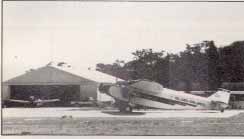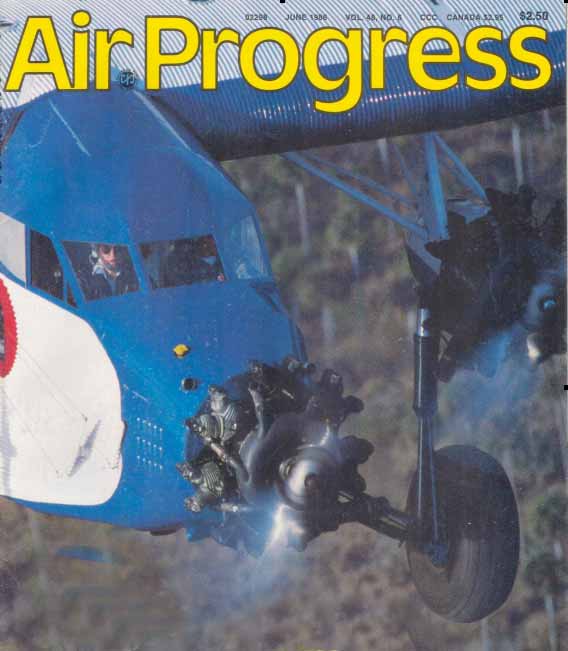PAGE THREE
 |
Talk about an airplane having
character! |
Editor O'Leary and Bruce Guberman, our always-famished
camera plane pilot, came drifting past and O'Leary motioned through
the open door to join up. Ed looked over and said (read that: shouted), "It's
you're airplane!" My first thought was, "You've got to be
kidding!" He wasn't and my first 45 minutes at the controls of
a Ford Tri-Motor were spent flying formation on a Seneca. Thanks to
Guberman's super smooth formation lead, things worked out
because once I got it in position the Ford's inherent stability took
care of the rest.
What kind of a formation bird is the Ford? Well, remember that Peterbilt
we mentioned? If anybody cares, the really grim looking guy in the
right seat is me. When I concentrate, I frown (and sweat) a lot. Photos
over, I decided to mess around with the Ford a bit, trying to discover
what I could of its personality in such a short time. In flying formation
I found it easy to coordinate and, when I pushed the rudder with no
aileron to check its effectiveness I found out why: Even though you're
perched on the beak of a really ancient bird, there is absolutely no
doubt when you are slipping or sliding. When I tried rolling into a
bank using only aileron, that center Wright J-6 looked really intent
on going the opposite direction. Point One: When flying a Ford Tri-Motor,
you coordinate. Period. If you don't it lets you know about it pronto.
Incidentally, if you want to talk about control response,
don't. The airplane has none. You can move the wheel forward and back
about six inches and roll the yoke 30 degrees either direction and,
if you continue moving forward and back, left and right, the airplane
blithely ignores you. It does absolutely nothing. You have to roll
in the aileron, wait until the airplane catches up with you and then
neutralize. A Pitts it ain't!
Then I brought the power back and hauled the nose up. Or at least tried
to. In a matter of seconds, I found myself with both arms wrapped around
the wheel, hugging it to my chest in an effort to keep the nose from
falling. Then, down around 63 mph, the airplane mushed slightly forward
and that was it. A little power put me back into aviating again and
I tried the same thing in a bank. Same thing happened. I gave the wheel
a bear hug and the (airplane gave me a sink rate of about 1000 fpm.
Power back in and the airspeed returning to its indicated cruise of
90 mph, I glanced left to clear traffic and at the same time caught
some extra faces in my peripheral vision. That's the first time I ever
did a stall series or flew formation with a half dozen people looking
over my shoulder! I had forgotten they were there. They certainly got
their twenty bucks worth! (They were jumpers so only got half of a
ride.)
I NEVER DID GET THE KNACK OF SYNCHING THE props on the three engines.
I understood the concept, but the concept on an old Ford is a lot different
than most multi-engine machines I'd flown. For one thing there was
one extra lever, but that wasn't the problem. The problem was that
you didn't get that rhythmic "beat" you get out of most twins,
when one prop is out of synch. First of all, the tachs are just tired
enough that you set no. 1 at 1800, no. 2 at 1820 and no. 3 at 1850.
That should be 1850 all around. I tried moving one throttle a couple
hundred rpm either direction. I could sense a change in the vibration,
but that was it. There was absolutely no "beat" to work with,
so I tried my best to even out the vibes, but I'm afraid my butt wasn't
in tune with the Ford, so I never got it exactly right.
 |
Island Airways operated
a bunch of Tri-motors as school buses for the Great Lakes islands. |
I drove us back onto downwind and saw Ed's hands creep back up onto
the wheel. By mutual consent, he would make the landing. Neither one
of us trusted me with his airplane, which coincidentally, was the last
known working Tri-Motor in the world.
Showing 75 to 80 mph on final, we gradually slowed to 70 mph or so
as we crossed the threshold. On the first landing, I was in the process
of being amused with Ed's rhythmic moving of the wheel fore and aft,
when I felt the wheels touch. We were so far in the air, that left
to my own devices I would have tried to land us another five feet under
the runway. On its main gear, the bird tracked ahead with only gentle
suggestions from the rudder about what it was or was not doing right.
The only part that looked truly tricky or unusual that was after the
tail came down and you had to maneuver it off the runway with the help
of the Johnson Bar. It was a little like using a tiller in a boat at
such a high speed was because we had a forward CG. With the CG further
back, it will go clear down to around 55 mph and keep flying. More
or less.
Ed Rusch continually refers to his blue collar antique as a "Cub
on stilts" and says you ". . . fly it like a Cub . . . three
times!" These are cliches he's used to using, but the funny thing
about cliches is that they are usually true. In this case, they are
absolutely true. The numbers in takeoff and landing are Cub-like and
the three tachometers fit the pattern. When those big airwheels kiss
the pavement, they remind you of nothing but a Cub.
This big Cub has a hard working past that few, if any, single airplanes
can match. Nearly sixty years of age and it is still making its own
way. All we can hope is that the plane continues until it flies past
the century mark. Right now, unfortunately, the barnstorming
Ford's future is questionable. The varied guardians of public safety
have hit it with such important necessities as liability
insurance premiums of $70,000 per ... and rising! This, combined with
the inherent problems of keeping three old-fashioned rubber
bands and an aging body airworthy, presents formidable obstacles.
Damn it, anyway! It would be absolutely criminal to see the barnstorming
Ford relegated to pure antique status. We have a number of them in
museums, so let's keep this one in the air where it should be but not
have it stuck out there like so many antique airplanes are, like some
sort of giant model airplane to be gawked at. This is one of the last
chances so many of us will ever have to see where air transportation
got its start. Our kids today have grown used to Space Shuttles, satellites
and 747s. They absolutely have to know where those all came from and
nothing will brand it so indelibly on their minds as a hop
around the patch in a Ford Tri-Motor. What a travesty it will be if
the combined greed of consumers who can't watch out for themselves,
lawyers, insurance companies and stone blinds bureaucrats slam a door
that presents a truly unique look at our past. Let's hear it for pushing
the retirement age for this hard-working antique into the next millennium!
SPECIFICATIONS
FORD 4-AT-B TRI-MOTOR
Span ............................................................ 74 ft
Length ................................................ 49 ft 10 in
Height ................................................... 12 ft 8 in
Chord at Root ........................................... 154 in
Chord at Tip ............................................... 92 in
Wing Area ............................................. 785 sq ft
Empty Weight ....................................... 6169 lbs
Gross Weight ..................................... 10,130 Ibs
Useful Load ........................................... 3900 lbs
Payload ................................................. 2200 lbs
Maximum Speed ................................... 114 mph
Cruise Speed ........................................... 95 mph
Landing Speed ........................................ 55 mph
Rate of Climb ........................... 750 fpm (initial)
Ceiling .................................................. 12,000 ft
Fuel ................................................... 235 gallons
Range ................................................... 520 miles |
| |
For
lots more pilot reports like this one go to PILOT
REPORTS
|

